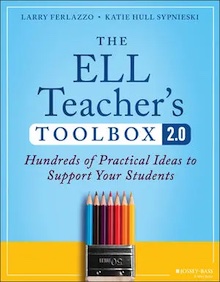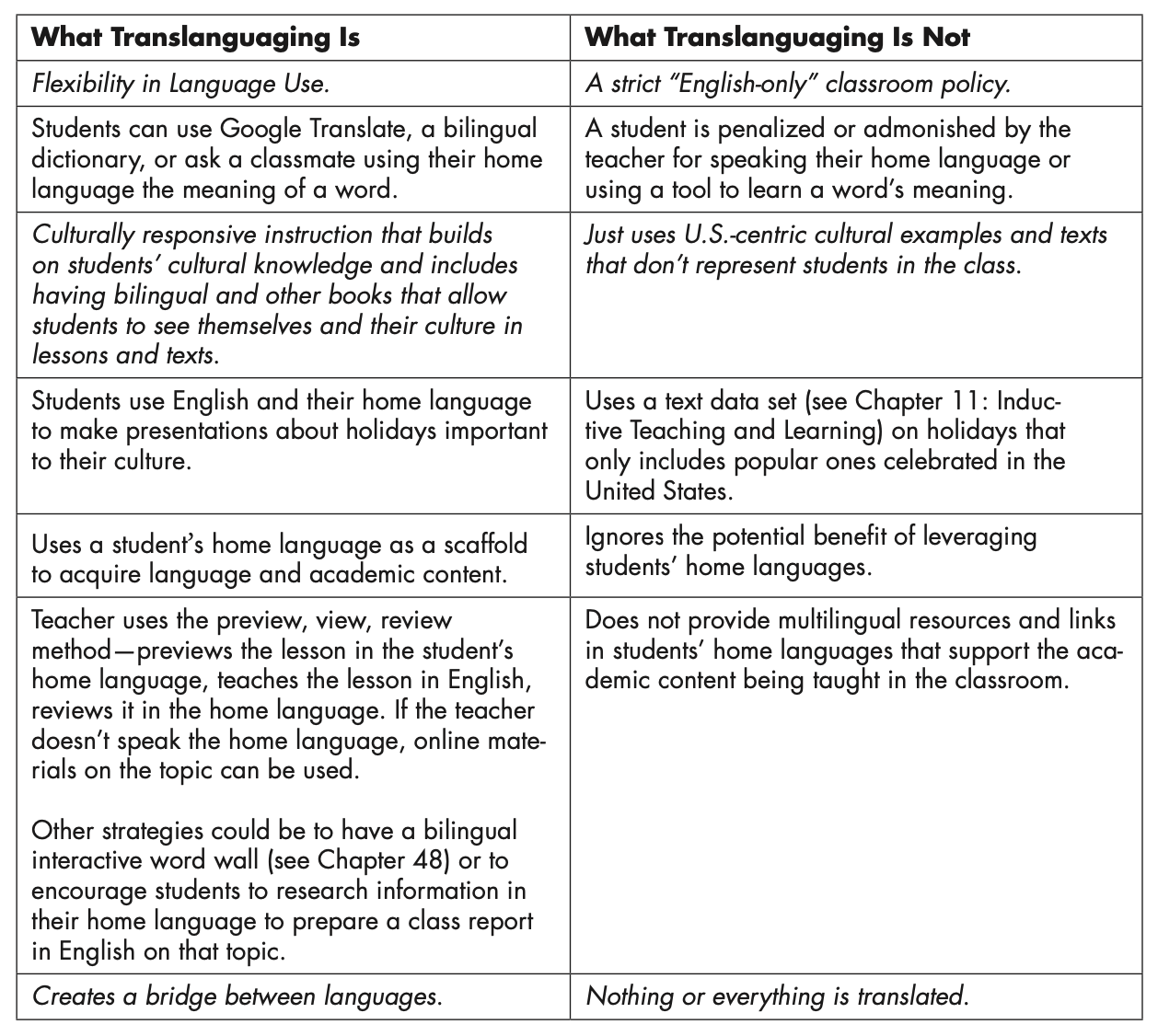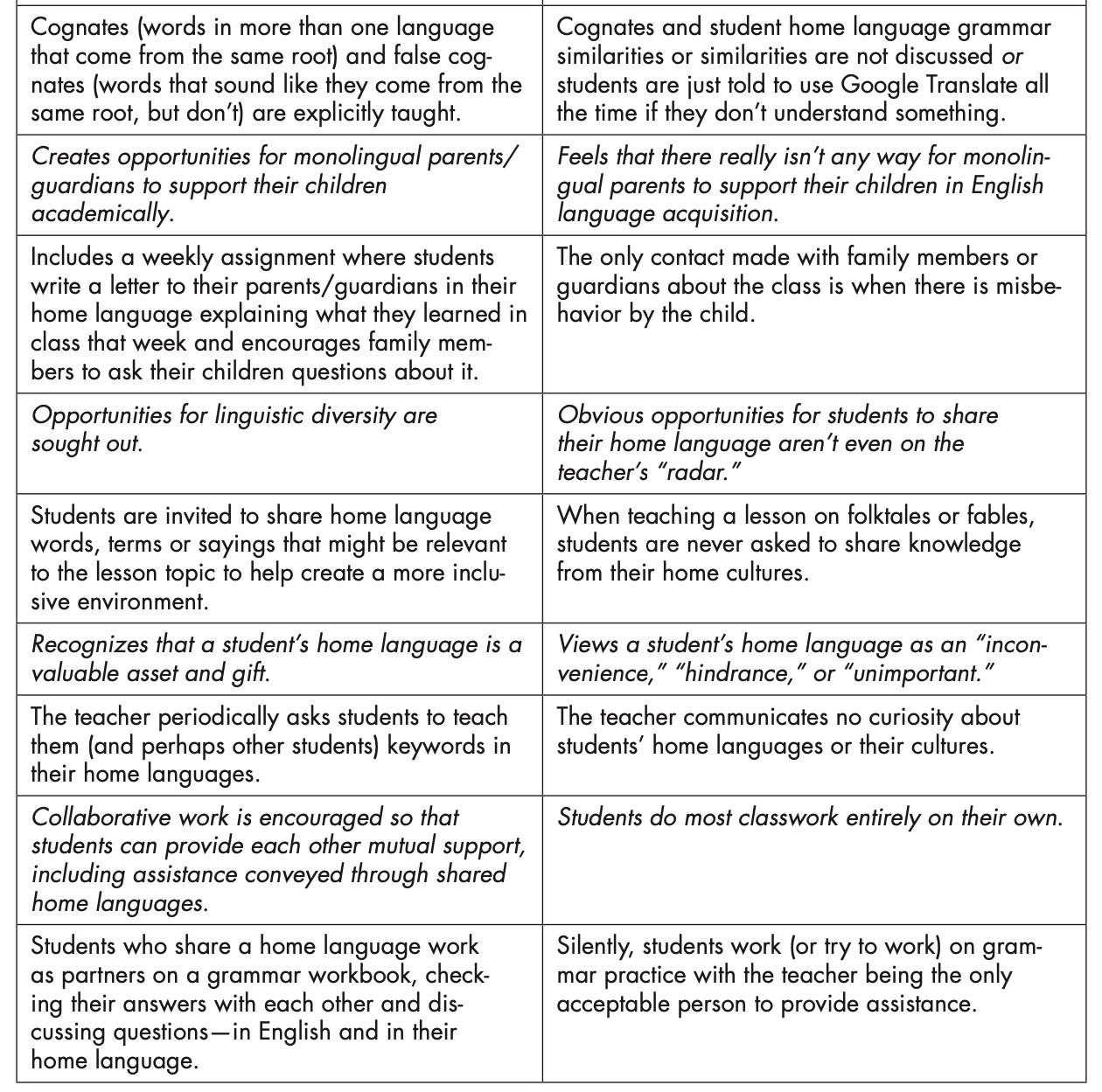By Larry Ferlazzo and Katie Hull Sypnieski


Larry
If we teach and work with multilingual students, we often hear about translanguaging. But just what is it?
Translanguaging can have different meanings. In the classroom, it basically means honoring students’ use of their home languages as a way to help them learn English and understand the academic content that’s being taught.


Katie
It doesn’t really mean “translating,” though translating some words could be a part of it. It’s a pedagogical strategy where we view students’ home languages as an asset they can use to more actively engage with the lesson we are teaching.
It’s about strategically using a student’s home language as a scaffold to help them achieve English language acquisition success, in addition to being a scaffold for an English language learner to learn higher-level academic content that they might not be able to access yet in English.
In our new book The ELL Teacher’s Toolbox 2.0: Hundreds of Practical Ideas to Support Your Students, we discuss the importance of teachers having an “asset-based mindset.” Why wouldn’t we want to leverage one of our students’ biggest assets – their home language – to help them learn what we are teaching?
The Supporting Research
Extensive research finds that translanguaging results in increased English language acquisition (Najarro, 2023; Champlin, 2016; McLaughlin, 2022). At the same time, however, researchers have found that teachers can be unsure of its meaning and how it can benefit their students (Champlin, 2016). We hope this article can be helpful in dealing with these concerns.
Common Core Connections
Translanguaging can be used to help ELLs achieve any and all of the Common Core Standards, depending on how it’s being used and in what class or lesson. Using their home language as a scaffold increases the odds of ELLs being able to meet those standards prior to gaining academic fluency in English, which can take many years (Hesson et al., 2014).
How Do We Use Translanguaging in Class?
We think that the best way to describe how translanguaging can work in the ELL classroom is by sharing these infographics from our book showing what translanguaging is and what that looks like (column one) and what translanguaging is not and what that looks like (column two). Each italicized point is followed by one or more examples. (Ignore the space between the two sections of the chart.)
Though we’ve framed the information in this infographic as either/or propositions, it’s important to note that there are many gray areas in the use of translanguaging.
For example, supporting a student’s home language does not mean you can’t have rules about the use of Google Translate when students are writing (our own rule is to “Use it for words and not sentences”). You might even have a five-minute “English-only” time for a particular activity. The goal is to make translanguaging an essential, frequently used technique – both in advancing students’ English language acquisition and assuring that they have every opportunity to learn higher level academic content.
Teaching Online
All of these translanguaging strategies can be used in an online environment. However, it’s critical for the teacher to initiate clear discussion about what translanguaging is and when it’s appropriate to use. If not, some students might decide instead to go “all in” on translating everything.
What Could Go Wrong?
The key to translanguaging success is to use it strategically. The teacher needs to proactively plan for it and discuss reasons and times for its use with students. Learning English is hard. Without these understandings, a not insignificant number of students may choose to use their home language to avoid some of the challenging – yet necessary – tasks involved in learning a language.
We also suggest that teachers try to become familiar with common classroom inappropriate words (e.g., curse words) in your students’ home languages. Trust us, those will be among the first words some students will want to use and others will want learn!
Other resources
► Tan Huynh’s MiddleWeb article “Translanguaging Lets MLs Use All Their Tools” shares useful insights and teaching ideas.
Additional resources to support translanguaging can be found at these links on Larry Ferlazzo’s website:
► The Best Resources for Learning About Translanguaging
► The Best Resources Explaining Why We Need to Support the Home Language of ELLs
► The Best Places Where You Can Order Bilingual Books
Feature image: Most-spoken languages, via Visual Capitalist.
Portions of this article adapted from The ELL Teacher’s Toolbox 2.0.

 Larry Ferlazzo teaches English Language Learners and English-proficient students at Luther Burbank High School in Sacramento, California. He has written, co-authored, or edited thirteen books on education, including The ELL Teacher’s Toolbox 2.0: Hundreds of Practical Ideas to Support Your Students (2nd Edition) and The ESL/ELL Teacher’s Survival Guide.
Larry Ferlazzo teaches English Language Learners and English-proficient students at Luther Burbank High School in Sacramento, California. He has written, co-authored, or edited thirteen books on education, including The ELL Teacher’s Toolbox 2.0: Hundreds of Practical Ideas to Support Your Students (2nd Edition) and The ESL/ELL Teacher’s Survival Guide.
Katie Hull Sypnieski has co-authored three books on teaching ELLs, including The ELL Teacher’s Toolbox 2.0: Hundreds of Practical Ideas to Support Your Students (2nd Edition) and The ESL/ELL Teacher’s Survival Guide. She teaches English Language Learners and English-proficient students in California. She is also a Teacher Consultant with the Area 3 Writing Project at the University of California.










